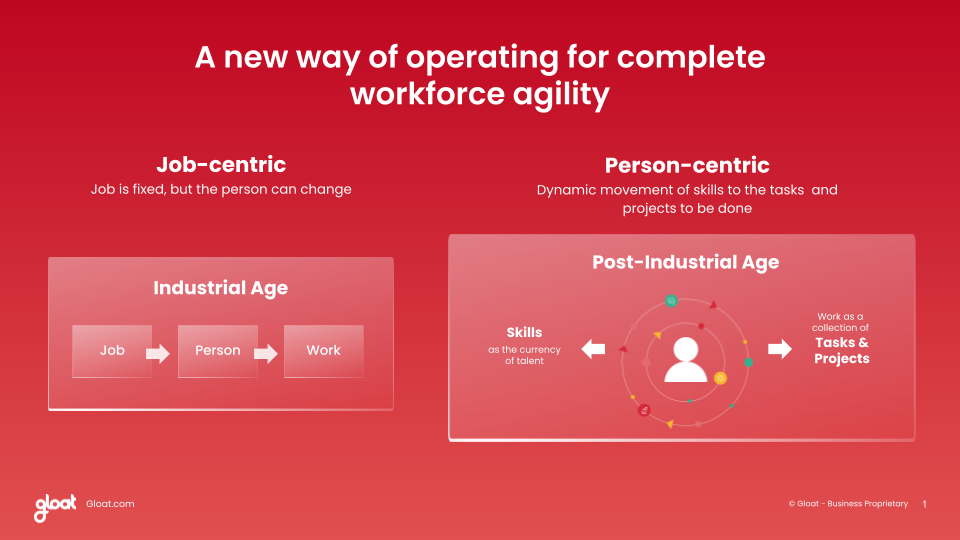Why are talent development processes so important?
Nurturing your workforce benefits your people and your business. Here’s why:

The hiring landscape that leaders are encountering today is uncharted territory. There’s fierce competition for in-demand skills and a scarcity of top-tier applicants with the knowledge needed to step into high-priority roles with confidence.
While leaders may have prioritized external hiring to fill vacancies in years past, savvy executives recognize that they must turn their attention inward to thrive in today’s hyper-competitive landscape. And that means putting an emphasis on developing the talent they already have.
From improving retention rates to minimizing sourcing and recruiting costs, talent development processes offer a host of benefits to businesses and the people who work for them.
What is talent development?
Talent development is the process of improving employee skills, knowledge, and performance to support career growth and organizational success. It includes training, coaching, mentoring, and learning programs that help individuals reach their potential and meet business goals effectively.
What’s the difference between talent development and talent management?
These two terms get used interchangeably from time to time, but there are actually a few key differences that set them apart. First off, talent development is focused on continuous growth and employee learning, while talent management is about strategically maximizing individual talent. Additionally, the focus of talent development is individualized learning and growth plans, while talent management is an organizational strategy for finding, hiring, and retaining top talent. Talent management strategies also include the recruiting process as well as succession planning.
Talent management versus performance management?
Similarly, talent management and performance management might sound similar, but each phrase has a distinct meaning. Performance management is an HR function that aims to maximize employee potential by developing their goals in line with the company’s needs. It’s about setting expectations, monitoring how team members are working, and assessing areas for improvement. In contrast, talent management prioritizes growth and development opportunities to ensure employees are building the skills they need to take their careers to the next level. It encompasses recruiting and succession planning, while performance management is solely about optimizing employee achievements and output levels.
The importance of talent development for your organization’s success
As consumer expectations shift and AI use cases go mainstream, businesses can’t afford to make talent development processes an afterthought. Now that we’re entering The Fourth Industrial Revolution—a time in which advances in AI and automation change the way we work—employees must hone new skills to take advantage of emerging technologies.
Since the pace of change is accelerating and the half-life of skills is shrinking, employees must develop different sets of competencies so they can adapt to new ways of working. The World Economic Forum predicts that the rise of AI and automation will create as many as 69 million new roles, which will come with new sets of expertise required to perform them correctly. Businesses must prepare their workforces for these forthcoming positions by prioritizing talent development today so people can get a headstart on building the skills they’ll need to succeed in tomorrow’s working world.
The benefits of prioritizing talent development
While it takes time and effort to devise an impactful talent development initiative, both employees and employers have a lot to gain from the right approach, including:
Improve performance and productivity
If you want to inspire your people to soar past their KPIs and work more efficiently, talent development needs to be a priority. When employees understand their roles and possess the skills and tools they need, they’ll make fewer errors and can complete tasks in record time.
Reduce skill gaps
Talent development and skills are not the same thing. However, the best talent development strategies always empower employees to expand their skill sets, through both targeted L&D curriculums and experiential development opportunities like mentorships. Since 87% of companies globally acknowledge that they have a skills gap, encouraging employees to learn and grow will be crucial for acquiring the competencies you’ll need to thrive in your next chapter.
Retain and engage employees
A lack of growth opportunities is one of the top reasons why employees are looking for new jobs, as our own research shows. Whether your employees are hoping to stay in their domain or channel their experience into new roles, employers need to demonstrate that their people have a bright future with their organization if they want to retain and engage them.
Higher ROI on L&D investments
Leaders who launch a talent development strategy with concrete skill-building goals are likely to see a much higher return on their L&D investments than executives without a comprehensive initiative. When talent development is aligned with L&D and overarching business priorities, there’s no risk that employees are wasting time learning skills that won’t be useful for your organization’s future.
Prepare for the future of work
The World Economic Forum predicts that as much as 50% of the global workforce will need reskilling by the end of this year. Instead of watching knowledge gaps widen, a talent development plan can encourage your employees to proactively start honing their skills and developing new expertise so that you can outpace your competition.
Why promoting diversity and inclusion must be a talent development priority
While most organizations are striving to make their workplaces more equitable, plenty of diversity and inclusion initiatives continue to miss the mark. Nearly one in two CEOs currently rank building a diverse and inclusive workforce as one of their top challenges for the year ahead.
Rather than relying on surface-level efforts like statements and surveys, leaders must reassess their talent development strategies to drive lasting change. In many organizations, access to career development opportunities hinges on external factors like who an employee knows and their geographic location.
To truly level the playing field, all employees must be able to see and apply for the same breadth of experiential learning opportunities as their peers. Once barriers to internal mobility are broken down, leaders can feel confident that their talent development strategy is making their organization a more equitable place to work.
Best practices for improving talent development strategies
Given the myriad of associated benefits, it’s no surprise that many organizations already have talent development plans in place. While any initiative is a step in the right direction, there are several best practices that leaders should keep in mind to ensure their talent development strategy gets the results they’re looking for.
#1. Give employees decision-making power
A cookie-cutter approach to talent development won’t do. Your people should play an active role in deciding the skills they want to develop, the roles they may wish to move into one day, and the types of learning opportunities that will help them get there. Since workers have more freedom and opportunity at their fingertips, it’s particularly important to ensure your people have a sense of agency when it comes to building their future within your organization.
#2. Create a culture that celebrates learning
For talent development programs to take off, learning and internal mobility need to be encouraged and celebrated at your organization. Make sure to recognize and reward internal role models who are actively participating in your talent development initiatives and share stories about what they’ve accomplished to inspire colleagues to follow in their footsteps.
#3. Remove boundaries and break down barriers
All too often, silos prevent organizations from reaping the full benefits of a talent development program. Just 10% of HR leaders say they have the technology and policies in place to connect employees to internal development opportunities, indicating that a lack of transparency is holding most workers back. Employees should have the chance to see and apply for opportunities across the organization and collaborate with colleagues in different departments so that both team members can expand their skill sets.
#4. Align development plans with business priorities
If you want to maximize the value of your talent development plan, you need to make sure that your employees’ learning experiences are aligned with your organizational goals and business priorities. Leading organizations are increasingly harnessing talent marketplaces to match employees to relevant experiential learning opportunities, such as projects, mentoring programs, and gigs.
5 core elements of an effective talent development program
If you’re looking to level up your talent development strategy, make sure your initiative includes each of the following components:
#1. Upskilling and reskilling employees
Skill-building is the backbone of any successful talent development program. Even the most senior employees in your organization should expand their skill sets, particularly as the rise of AI promises to change the capabilities employees need to be successful in their roles. The best development plans include both upskilling opportunities for employees who wish to deepen their subject matter expertise as well as reskilling pathways for people who are interested in taking their careers in new directions.
#2. Mentoring and coaching
Mentoring and coaching are surefire ways to encourage employees to grow their networks and skill sets simultaneously. These initiatives allow people to observe how their more experienced colleagues execute tasks and ask them questions throughout the process. Simultaneously, mentors will develop the leadership skills they need to confidently manage teams, creating a mutually beneficial relationship for everyone involved.
#3. Personalizing employee development plans
Talent development plans can’t be one-size-fits-all. Instead, employees should have the opportunity to gain hands-on experience in the fields that align with the skills they’re looking to build and the direction they wish to take their careers in.
To help employees deepen their understanding of various areas of the business, everyone should be encouraged to participate in projects and gigs within other departments. Many visionary companies are harnessing talent marketplaces to generate suggestions for projects, gigs, and even full-time roles that align with employees’ career aspirations.
#4. A culture of continuous learning
Executives should strive to partake in their own development opportunities and share their experiences with their colleagues and teams to inspire everyone to follow in their footsteps. To go the extra mile to create a learning culture, leaders should replace talent hoarding with talent sharing mindsets, as this type of company-wide mobility will help employees expand their expertise and fuel better cross-functional collaboration.
#5. Monitoring progress
A talent development plan isn’t complete once leaders have drafted it. Instead, executives must carefully monitor their organization’s skill-building efforts to determine who’s participating in development opportunities and how these opportunities are bringing employees closer to reaching their overarching goals.
Overcoming barriers to talent development
As leaders embark on their talent development journeys, there are a handful of challenges they should prepare for. One of the most common obstacles they might encounter is managers who are possessive of their direct reports and resistant to letting these employees lend their skills to other teams across the organization. While these talent hoarding tendencies may be fairly common, they aren’t doing your business any favors. Once employees are empowered to participate in cross-functional projects, they will be able to hone new skills while also breaking down silos and barriers that limit organizational productivity.
Another talent development challenge that leaders should have on their radar is uncertainty about what types of skills to prioritize. Particularly as AI usage becomes more widespread, many executives may be unsure about which capabilities will prove most important in the years to come. Rather than guessing, visionary executives are harnessing AI-powered skills intelligence systems to uncover the skills that are on the rise and on the decline in their industry. Armed with this information, leaders can then create talent development plans that prioritize these sought-after competencies.
How to upgrade talent development with an agile workforce operating system
In the past, talent development programs often fell flat because it was challenging to align every employee’s unique professional ambitions with organizational priorities. As a result, employees were often on the receiving end of development plans that failed to take their individual ambitions into account, causing team members to lose motivation and disengage.
While it is virtually impossible for enterprises to match employees to relevant growth opportunities manually, AI-powered technology puts company-wide visibility and alignment within reach for every organization. Agile workforce operating systems take the guesswork out of the equation by collecting information about an employee’s skills and experience and using these insights to generate suggested opportunities that align with both personal goals and organizational priorities. And unlike human decisions, the matches generated by these systems are free from bias. Ethically constructed AI enables leaders to see their people for their potential, maximize their talent development strategy, and make sure no one is overlooked.
To learn more about how to upgrade your talent development plan with AI, check out our guide, The business impact of workforce agility.




